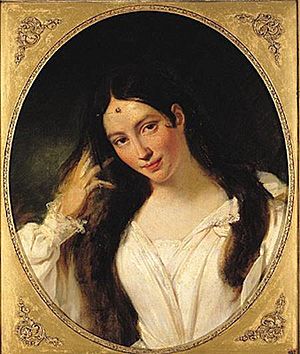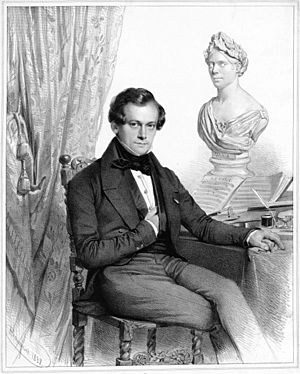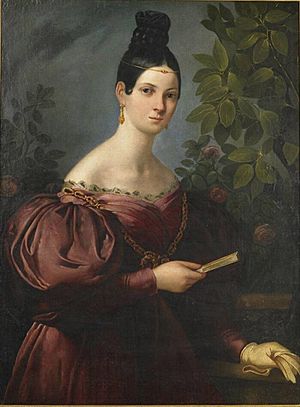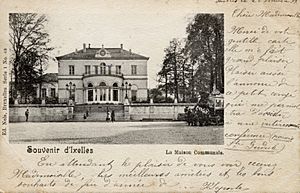Maria Malibran facts for kids
Maria Felicia Malibran (born March 24, 1808 – died September 23, 1836) was a very famous Spanish opera singer. She could sing both contralto (a low female voice) and soprano (a high female voice) parts. Maria was known for her strong personality and powerful performances. She became a legend after she passed away at just 28 years old. People who heard her sing said her voice was amazing. It had a huge range, was very powerful, and could be used in many flexible ways.
Contents
Maria Malibran's Life and Career
Maria Malibran was born in Paris. Her full name was María Felicitas García Sitches. She came from a well-known Spanish family of musicians. Her father, Manuel García, was a famous tenor (a high male singing voice). He was admired by the composer Gioachino Rossini. Manuel García also created the role of Count Almaviva in Rossini's opera The Barber of Seville. Maria's father was also a composer and a very important voice teacher. He was her first singing teacher. Their lessons were often difficult because both Maria and her father had very strong personalities.
Early Singing Days

Maria first performed on stage in Naples, Italy, when she was only 8 years old. She sang with her father in an opera called Agnese. When she was 17, she joined the choir at the King's Theatre in London. One day, the main singer, Giuditta Pasta, was unable to perform. Maria's father suggested that his daughter take her place. Maria sang the role of Rosina in The Barber of Seville. The audience loved the young singer, who had a mezzo-soprano voice (a middle female voice). She continued to sing this role for the rest of the season.
Later Performances and Challenges
After the London season ended, Maria's father took his opera group to New York. This group was mostly made up of his family members. It included Maria, her brother Manuel, and their mother, Joaquina Sitchez. Maria's younger sister, Pauline Viardot, who would also become a famous singer, was only four years old then.
This trip was important because it was the first time Italian opera was performed in New York. For nine months, Maria sang the main roles in eight operas. Her father had written two of these operas. In New York, Maria met and quickly married a banker named Francois Eugene Malibran. He was 28 years older than her. Some people believe her father made her marry him. Others say she married him to get away from her strict father. A few months after their wedding, her husband lost all his money. Maria had to support him with her singing performances. After about a year, she left Mr. Malibran and went back to Europe.

In Europe, Maria sang the main role in the first performance of Gaetano Donizetti's opera Maria Stuarda. This opera was based on a play about Mary, Queen of Scots. The story showed Mary in a kind way, so the people in charge of checking plays (censors) asked for changes to the words. Maria often ignored these changes. The Library of the Royal Conservatory of Brussels has some interesting costume designs for this play that Maria created herself. This shows she was also a talented artist.
Maria became partners with a Belgian violinist named Charles Auguste de Bériot. They lived together for six years and had a child in 1833, a son named Charles-Wilfrid de Bériot. Later, Maria was able to end her first marriage to Mr. Malibran. The composer Felix Mendelssohn even wrote a special song for Maria and Charles-Auguste, with a solo violin part. Maria sang in many major opera houses, including the Paris Opera. In Paris, she met and performed with the musician Michael William Balfe.
Last Years and Passing
In 1834, Maria Malibran moved to England and began performing in London and other parts of Europe. In Venice, Italy, she performed in Vincenzo Bellini's opera La sonnambula in 1835. She gave her performance to help a very old theater called Teatro San Giovanni Grisostomo. Her help inspired people to fix up the theater. It was later renamed Teatro Malibran in her honor, and she was seen as its special helper. In May 1836, she starred in The Maid of Artois, an opera written just for her by Balfe. Earlier that year, she sang the main role in the first performance of Vaccai's Giovanna Gray in Milan.
In July 1836, Maria had an accident. She fell from her horse and was hurt. She never fully recovered from these injuries. She refused to see a doctor and kept performing. In September 1836, Maria was in Manchester, England, for a music festival. She collapsed on stage while singing extra songs at the theater. Even after this, she insisted on performing the next morning at the church. She passed away a week later. Her body was first buried in the church. Later, it was moved to a special tomb in Laeken Cemetery, near Brussels in Belgium. The Library of The Royal Conservatory of Brussels has many items related to Maria, including a special report from her doctor about her passing.
Maria Malibran's Roles and Singing Style
Maria Malibran is most famous for singing in operas by Gioachino Rossini. The composer Rossini praised her greatly, saying she was an amazing person with incredible musical talent. He said she was better than anyone else and had a brilliant mind and fiery spirit.
She sang the main roles in Rossini's operas Tancredi and Otello. In Otello, she even sang both the parts of Desdemona and Otello. She also performed in Il turco in Italia, La Cenerentola, and Semiramide.
Maria also sang in Giacomo Meyerbeer's Il crociato in Egitto in Paris in 1825. This opera helped Meyerbeer become famous across Europe. Maria had great success in Vincenzo Bellini's operas like Norma, La sonnambula, and I Capuleti e i Montecchi (where she sang the role of Romeo). She also sang the Romeo role in two other famous operas: Giulietta e Romeo by Niccolò Antonio Zingarelli and Giulietta e Romeo by Nicola Vaccai. Bellini even wrote a new version of his opera I puritani to fit her voice. He promised to write a new opera just for her, but he passed away before he could.
Maria's tessitura (the comfortable range of notes she could sing) was very wide. She could sing from low E♭ to high C and D. This allowed her to easily sing roles meant for both low female voices (contralto) and high female voices (soprano). People who saw her perform admired her strong emotions on stage. Famous people like Rossini, Donizetti, Frédéric Chopin, Mendelssohn, and Franz Liszt were all her fans. However, the painter Eugène Delacroix thought she lacked elegance and tried too hard to please regular people who didn't have "artistic taste." A French critic named Castil-Blaze described her voice as "vibrant, full of brightness and vigor." He said she had amazing speed, accuracy, and could sing beautiful musical patterns like arpeggios.
Maria Malibran's Legacy
Teatro Malibran
Maria Malibran is the special patroness of the Teatro Malibran in Venice, Italy. A small statue of her head hangs above the stage there.
Maria Malibran Fund
The Library of the Royal Conservatory of Brussels has a large collection of music, documents, and items that belonged to Maria Malibran. This collection is called the Maria Malibran fund.
Films About Maria Malibran
Several movies have been made about Maria Malibran's life:
- Maria Malibran (1943) was an Italian film directed by Guido Brignone. It starred Maria Cebotari, an opera singer and actress.
- La Malibran (1944) was a French film directed by Sacha Guitry. It starred Géori Boué, a famous singer from the Paris Opera.
- Malibran's Song (1951) was a Spanish film directed by Luis Escobar Kirkpatrick.
- The Death of Maria Malibran (1972) was a German film directed by Werner Schroeter. It starred Candy Darling.
Maria Malibran in Other Media
In 1982, the famous soprano singer Joan Sutherland went on a concert tour called "Malibran." She sang songs that Maria Malibran loved to help people remember her.
The mezzo-soprano singer Cecilia Bartoli made her 2007 album Maria about the music written for Malibran and her most famous roles. She also went on a big concert tour and released a DVD dedicated to Maria Malibran. In 2008, a recording of Bellini's La Sonnambula was released with Cecilia Bartoli singing the main role. This recording used many of the special musical additions that Maria Malibran herself used.
Letitia Elizabeth Landon wrote a short poem about Maria Malibran in a book called The English Bijou Almanack in 1837.
Maria Malibran also appears as a character in a poem by William McGonagall.
Mark Twain's daughter, Susy Clemens, wrote a final poem addressed to Malibran before she passed away from spinal meningitis. Susy saw Maria as a special helper or saint.
Genealogy
- Manuel García (1775–1832), singer, composer, impresario; married Joaquina Sitches (1780–1864)
- Manuel García Junior (1805–1906), singer, composer, singing teacher; married Cécile Maria "Eugénie" Mayer (1814–1880)
- Manuel García (1836–1885)
- Gustave García (1837–1925), baritone and singing teacher; married Emily Matilda Ann Martorell (1835–?)
- Alberto García (1875–1946), baritone
- Eugenie Harouel (1840–1924)
- Marie Crèpet (1842–1867)
- Maria Malibran (1808–1836), singer; married Francois Eugene Malibran (1781–1836) (no children); married Charles Auguste de Bériot (1802–1870), composer, violinist
- Charles-Wilfrid de Bériot (1833–1914), pianist, composer, professor at the École Niedermeyer
- Pauline Viardot (1821–1910), singer, composer; married Louis Viardot (1800–1883)
- Louise Héritte-Viardot (1841–1918), composer, pianist, singer
- Paul Viardot (1857–1941)
- Marianne Viardot (1854–1919), painter, briefly engaged to Gabriel Fauré; married Alphonse Duvernoy
- Claudie Viardot (1852–1914); married Georges Chamerot; had issue
- Manuel García Junior (1805–1906), singer, composer, singing teacher; married Cécile Maria "Eugénie" Mayer (1814–1880)
See also
 In Spanish: María Malibrán para niños
In Spanish: María Malibrán para niños





